Dear Readers,
There’s something extremely terrifying brewing right now.
The media has mostly turned a blind eye to it, even though it should be splattered across the front page of every newspaper.
In fact, what’s happening now could completely change the world in ways we can’t imagine.
I urge you to read this Letter in its entirety. Perhaps after reading it, you may see things in a different light.
Here we go.
Watch the Video Instead:
Hear the Podcast Instead:
Apple Podcasts (click to download to your iPhone, iPad, or Mac): https://podcasts.apple.com/ca/podcast/may-2019-investing-through-a-nuclear-arms-race/id1462392573?i=1000440250955
MP3 (right click > save as): http://traffic.libsyn.com/equedia/May_2019_compressed.mp3
The Nuclear Arms Race
Last month, I ended my Letter, “A Most Radical Prediction,” with a very dramatic hanger:
“…to correct the current global debt bubble, something massive will have to take place – something no one will be able to grasp until it happens.
During this time of radical change, countries around the world will be afraid and begin to defend themselves from the fall out of the credit bubble.
Unfortunately, massive global resets have only really occurred as a result of war.
Are we on that path?”
Call it a coincidence, but shortly after I wrote that, the world changed very quickly – and not for the better.
Just last week, a senior U.N. security expert told us that the risk of nuclear war is higher now than any time since WW2.
She called it an “urgent” issue that the world should take more seriously.
Via Reuters:
“Renata Dwan, director of the U.N. Institute for Disarmament Research (UNIDIR), said all states with nuclear weapons have nuclear modernization programs underway and the arms control landscape is changing, partly due to strategic competition between China and the United States.”
Not Even Close
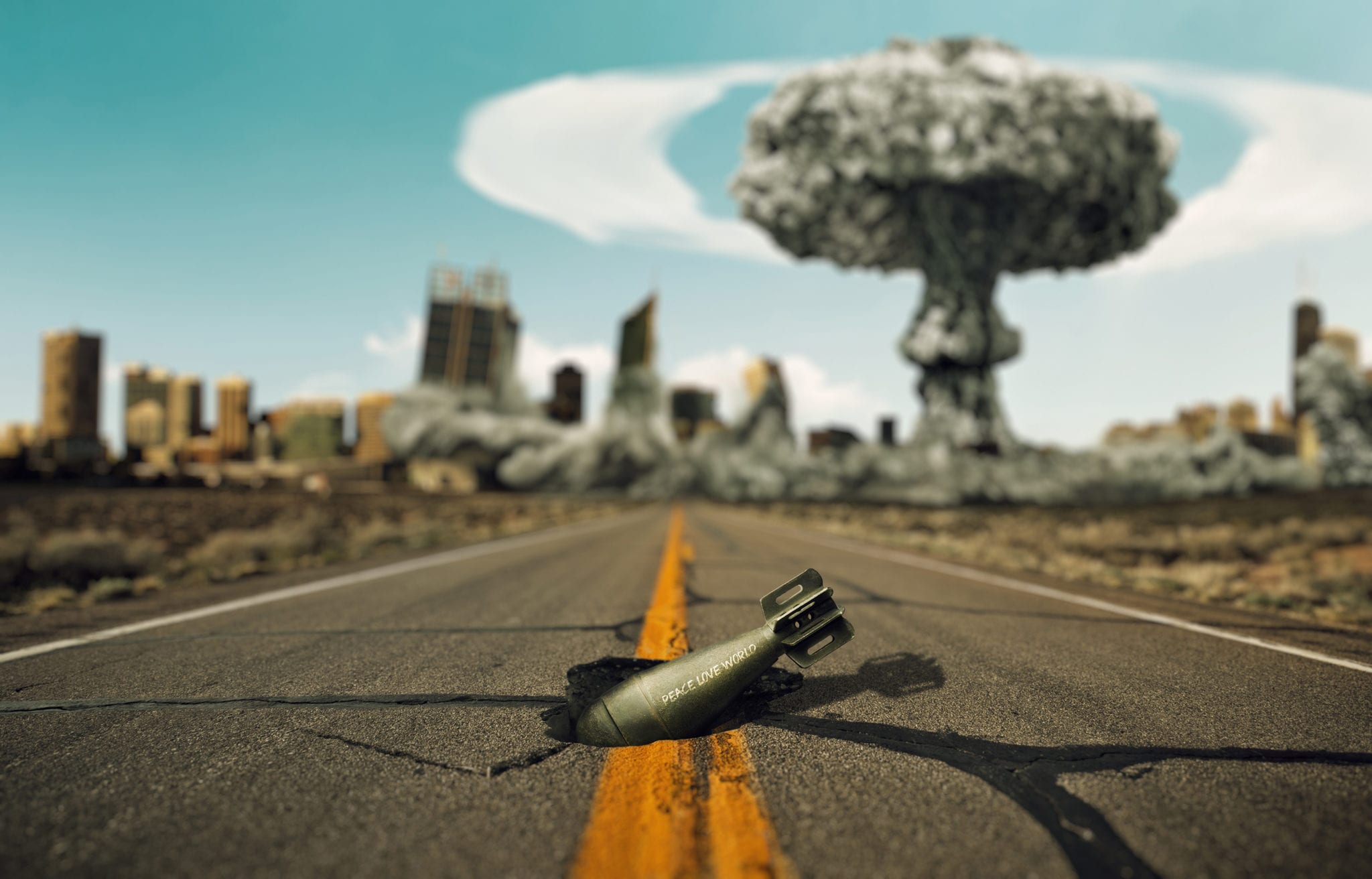
Over the past two decades, 122 countries have signed a treaty to ban nuclear weapons.
This treaty, called the Treaty for the Prohibition of Nuclear Weapons, was backed by the International Campaign to Abolish Nuclear Weapons (ICAN) – a campaign that won the Nobel Peace Prize in 2017.
But this treaty – one that makes complete sense for mankind – is not even close to being finalized.
It’s not even halfway there.
The treaty has so far gathered just 23 of the 50 ratifications that it needs to come into force.
Countries such as Thailand, Vietnam, South Africa, and even Mexico have already signed the Treaty.
But the United States and Russia – and many other states with nuclear arms – have not. In fact, these power states strongly oppose it. I guess power is a hard thing to give up.
It’s no wonder that since last year, the Doomsday Clock has been set only two minutes away from midnight – something not seen since 1947.
What’s the Doomsday Clock?
Via the Bulletin of the Atomic Scientists:
“Founded in 1945 by University of Chicago scientists who had helped develop the first atomic weapons in the Manhattan Project, the Bulletin of the Atomic Scientists created the Doomsday Clock two years later, using the imagery of apocalypse (midnight) and the contemporary idiom of nuclear explosion (countdown to zero) to convey threats to humanity and the planet.
The decision to move (or to leave in place) the minute hand of the Doomsday Clock is made every year by the Bulletin’s Science and Security Board in consultation with its Board of Sponsors, which includes 15 Nobel laureates.
The Clock has become a universally recognized indicator of the world’s vulnerability to catastrophe from nuclear weapons, climate change, and new technologies emerging in other domains.”
So where are we today?
Negotiation Stalemate
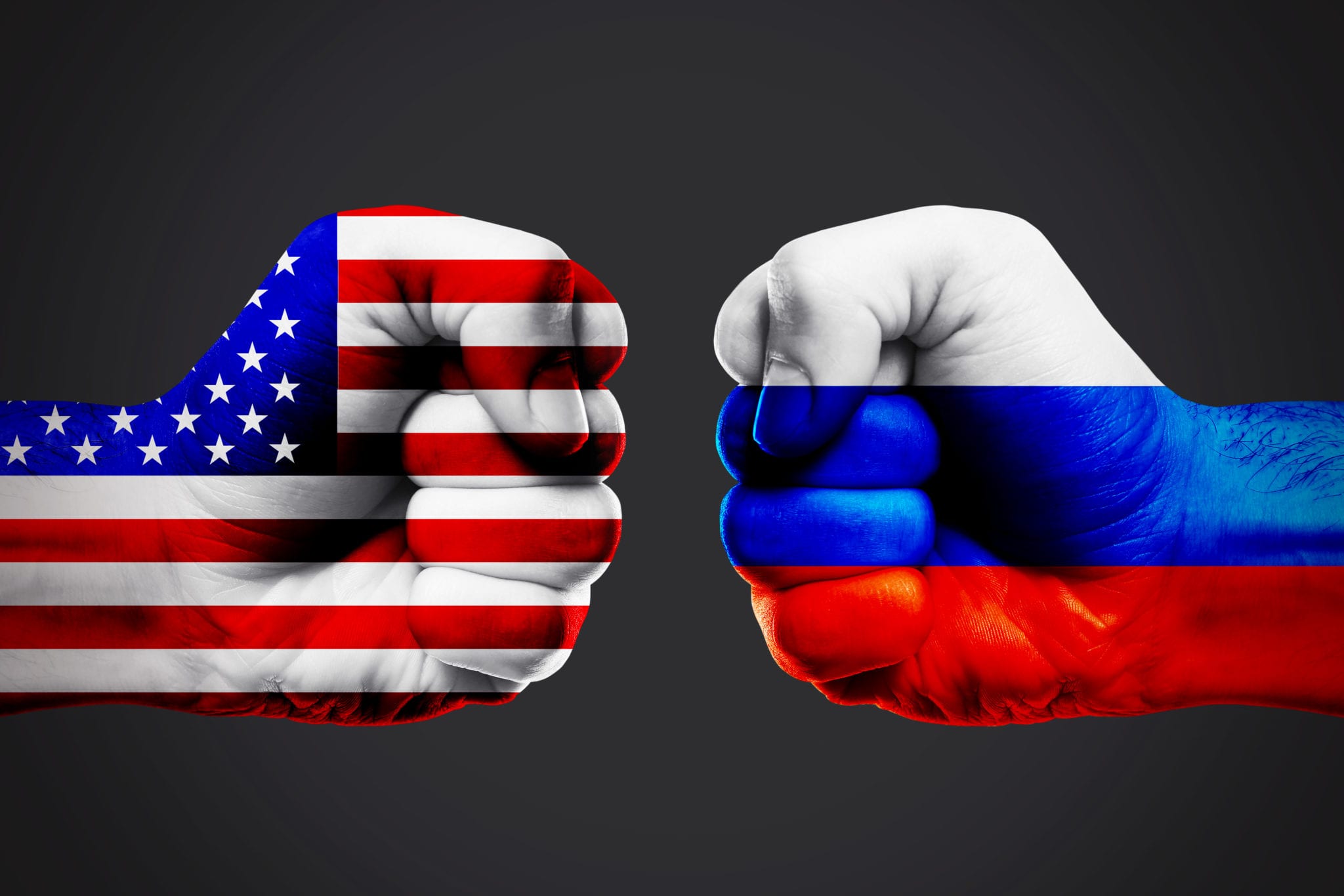
The two most powerful nuclear countries are Russia and the United States.
Russia has 6850 nuclear-capable warheads – the most in the world; the United States a close 2nd with 6550.
Both countries have been upgrading their nuclear arsenal at a staggering pace.
Russian President Vladimir Putin even bragged about Russia’s new weapons last year – showing how it could destroy anyone around the world who stood in its way.
And in less than two years, in February 2021, the 2011 New Strategic Arms Reduction Treaty (New START), a massive nuclear arms treaty between Russia and the United States and the only U.S.-Russia arms control pact limiting deployed strategic nuclear weapons, ends.
It’s why, earlier this month, U.S. President Donald Trump said he and Russian President Vladimir Putin discussed the possibility of a new accord – one that could even include China.
More on China in a bit.
While a new nuclear accord between the two biggest nuclear powers would ease global tensions, it seems we’re much further away than we are close to an agreement.
Why?
Because the U.S. has now withdrawn from both the Anti-Ballistic Missile Treaty (ABM Treaty) and the Intermediate-Range Nuclear Forces Treaty (INF Treaty). These are actions that Russia feels will not only lead to an arms race, but lead to consequences worse than the Cold War.
Via Telesur in March:
“At the Conference on Disarmament held in Geneva, the Russian Foreign Minister Sergei Lavrov warned Wednesday that the U.S. recent withdrawal from both the Anti-Ballistic Missile Treaty (ABM Treaty) and the Intermediate-Range Nuclear Forces Treaty (INF Treaty) leads to an “Arms race” with likely worse consequences than the Cold War’s one.
“Washington made no secret of an intention to have their hands free in order to build up unrestricted missile capabilities in the regions where the U.S. tends to push through their own interests,” the Russian top diplomat said and explained that the U.S. withdrawal from the ABM and INF treaties “could lead to a renewed widescale arms race with unpredictable consequences.”
It would seem Russia is right: a new arms race has begun.
In fact, it’s been happening right under our noses over the past few years…
Don't Miss Our Next Report !
...get a free monthly subscription to one of the best-performing investment letters: the Equedia Letter
*Don't worry. We will never spam you and our subscription comes only once per month. You can unsubscribe anytime with a simple click.
One Trillion Dollars
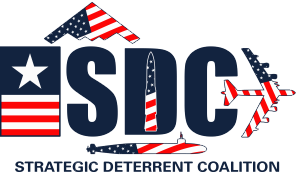 Back in 2016, senior U.S. military and nuclear weapons officials convened in Albuquerque to promote a $1 trillion nuclear weapons plan.
Back in 2016, senior U.S. military and nuclear weapons officials convened in Albuquerque to promote a $1 trillion nuclear weapons plan.
The meeting was organized by the “Strategic Deterrent Coalition” (SDC). But who are they?
Via the SDC:
“The Strategic Deterrent Coalition (SDC) is a nonprofit, nonpartisan community-based organization formed to support the Nuclear Triad by providing educational information on the importance to our nation of maintaining a safe, secure, and effective nuclear deterrent.
The SDC’s purpose is to inform decision makers and thought leaders on how America’s nuclear weapons contribute to our strategic position, in a world where potential adversaries are modernizing, innovating, and gaining in almost every way. SDC focuses on the nation’s strategic deterrent – why it works, why it must be maintained, and how it contributes to global stability.
What is the Nuclear Triad?
The Nuclear Triad is America’s strategic nuclear deterrent, comprised of Intercontinental Ballistic Missiles (ICBMs), Submarine Launched Ballistic Missiles (SLBMs), and nuclear capable long-range bombers.
This three-branched nuclear capability creates a strong and credible deterrence, significantly reducing the possibility that an adversary would ever attack, or that they could destroy all of America’s nuclear forces in a first-strike.
The underlying foundation of the Triad is the ongoing maintenance and refurbishment of the nuclear stockpile conducted by the Department of Energy National Nuclear Security Administration national laboratories.”
In other words, the SDC is an organization that encourages the advancement of nuclear weapons because, ironically, they believe advancing nuclear weapons is the best deterrent against nuclear weapons.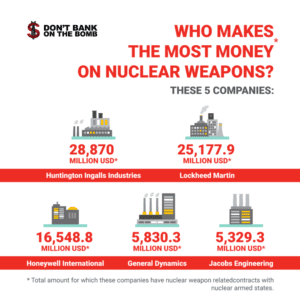
Go figure.
It should come as no surprise that the SDC meeting was funded by companies directly involved in the creation of nuclear weapons, including Northrup Grumman, Boeing, Orbital ATK, BAE Systems, and others.
It should also come as no surprise that while the stock market is down over the last month, companies involved in the arms race are doing just fine.
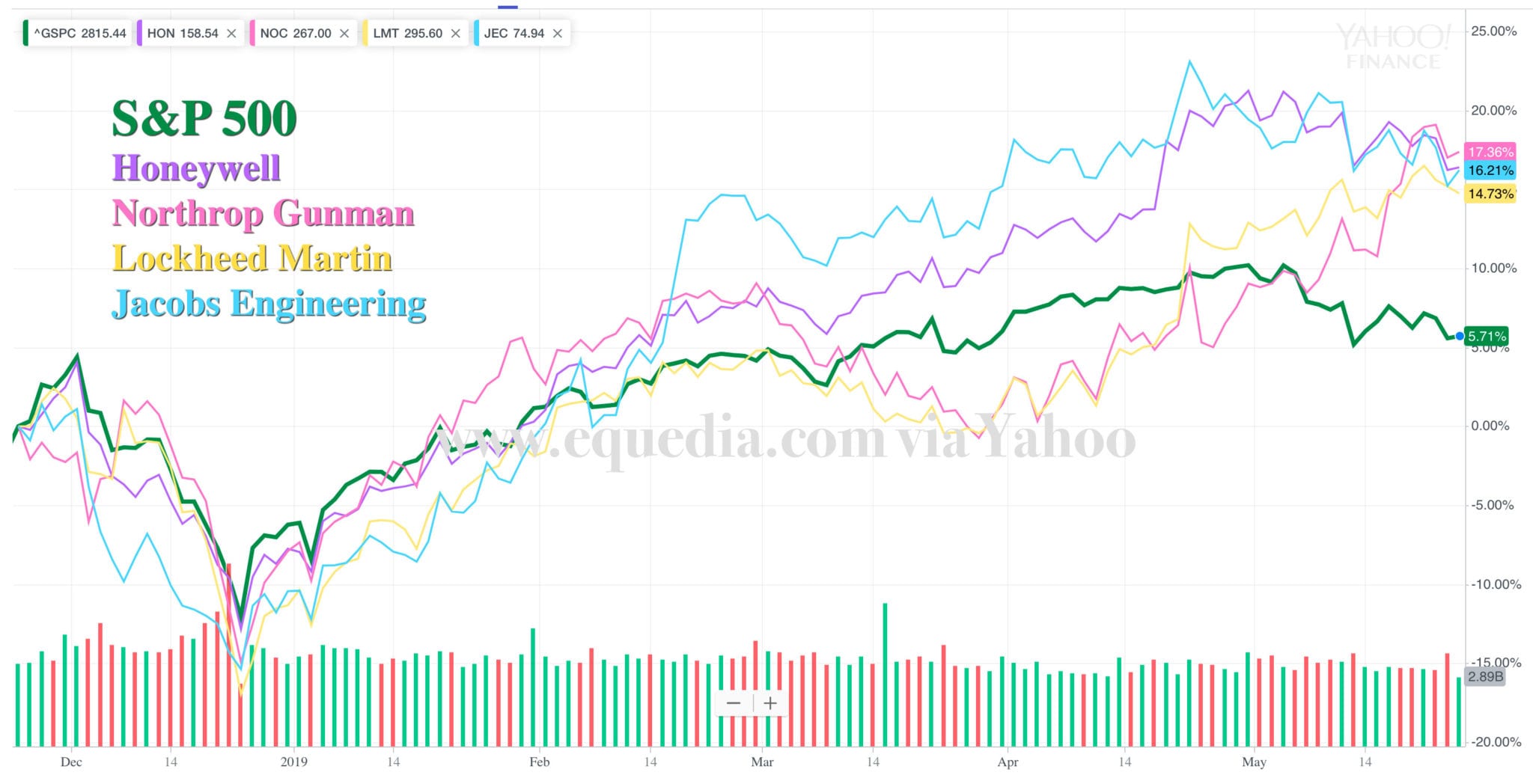 Record Military Spending
Record Military Spending
According to the Stockholm International Peace Research Institute (SIPRI), total world military expenditure has hit another record high, rising to US$1.8 trillion last year.
Via SIPRI:
“Total global military spending rose for the second consecutive year in 2018, to the highest level since 1988-the first year for which consistent global data is available. World spending is now 76 per cent higher than the post-cold war low in 1998.”
Meanwhile, America’s military budget is set to grow for a fifth consecutive year to near-historic highs in 2020. In fact, the U.S. remained by far the largest spender in the world and spent almost as much on its military in 2018 as the next eight largest-spending countries combined.
Via Washington Post:
“…The Trump administration has proposed $750 billion in defense spending as part of its budget request to Congress for next year…
…House Democrats in their budget proposed increasing defense spending to $733 billion a year…
…Under either budget plan, the United States is expected to spend more on its military in 2020 than at any point since World War II, except for a handful of years at the height of the Iraq War, said Todd Harrison, a defense budget expert at the Center for Strategic and International Studies, a think tank focused on foreign policy.”
Why is the United States increasing their defense spending?
Continued via the Washington Post:
“…Pentagon officials have said the additional resources are needed to counter military escalations in Russia and China, which have invested heavily in next-generation military weaponry.
Russia claims to have already developed a hypersonic missile that can travel faster than the speed of sound, something some defense hawks warn could threaten U.S. missile defense systems that were designed decades ago.
And China has invested heavily in new submarines, warships, and other war equipment as its defense budget ballooned.”
By now, I am sure you can see a common theme: rising tensions with the U.S. on one side, and Russia and China on the other.
China: The Quiet Assassin

While Russia and the United States are the two biggest nuclear powers, don’t think for one second that China isn’t preparing itself – especially with the ongoing trade war with the U.S.
In fact, China was the second-largest spender in the world, increasing its military expenditure by 5 per cent to $250 billion in 2018.
Via SIPRI:
“China, the second-largest spender in the world, increased its military expenditure by 5.0 per cent to $250 billion in 2018. This was the 24th consecutive year of increase in Chinese military expenditure. Its spending in 2018 was almost 10 times higher than in 1994, and accounted for 14 per cent of world military spending.
‘Growth in Chinese military spending tracks the country’s overall economic growth,’ says Tian. ‘China has allocated 1.9 per cent of its GDP to the military every year since 2013.'”
Together, the U.S. and China accounted for half of the world’s military spending.
And when it comes to nuclear weapons, China isn’t about to sign any treaties or back off in advancing it’s nuclear arms capabilities.
Remember earlier when I said Trump and Putin discussed the possibility of a new nuclear accord that could even include China?
Well, China responded right away.
Via Telesur earlier this month:
“China will not participate in negotiations on any trilateral nuclear disarmament agreement with the United States (U.S) and Russia, the Chinese Ministry of Foreign Affairs said Monday.
“We’re opposed to accusations from any country on arms control issues,” Foreign Ministry spokesperson Geng Shuang said during a press conference, dismissing altogether the possibility of joint talks as “our nuclear forces have been at the lowest level of national security needs and are not on the same scale with the United States and Russia.”
In other words, China is taking a page directly out of the SDC playbook: prevent nuclear war by creating more nuclear weapons.
But the tensions don’t stop there.
You see, the U.S. has been busy enforcing its power all over the world; sometimes as Protector, and other times as Aggressor.
For example, in the growing trade war between China and the U.S., the U.S. has already called on allies, such as Japan and the U.K, to halt the phone sales of China’s biggest cell phone manufacturer, Huawei Technologies Co.
And immediately, the U.S. allies complied.
Via the South China Morning Post:
“British and Japanese mobile phone companies said Wednesday they are putting on hold plans to sell new devices from Huawei, in the latest fallout from US tech restrictions aimed at the Chinese company.
Britain’s EE and Vodafone and Japan’s KDDI and Y! Mobile said they are pausing the launch of Huawei smartphones, including some that can be used on next generation mobile networks, amid uncertainty about devices from the world’s No. 2 smartphone maker.”
The U.S., acting as Protector, alleges that Huawei phones are a security risk.
And as Aggressor, the U.S. has been very aggressive.
Venezuela
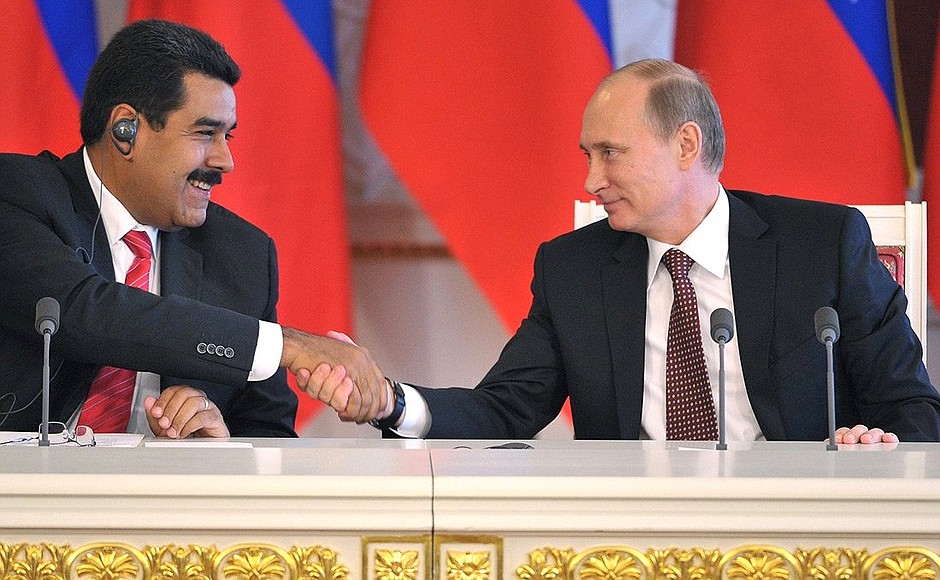
Venezuela is situated very close to the U.S.
And just as China and Russia don’t want the U.S. near its territories (think U.S forces in Syria and U.S warships in the South China Sea), the U.S. doesn’t want other countries such as Russia and China near its territories either.
So much so that as Russia and China grow their relations with Venezuela, the U.S. is attempting to put an end to that immediately.
Via AP News earlier last month:
“U.S. Vice President Mike Pence told the Security Council on Wednesday the Trump administration is determined to remove President Nicolás Maduro from power in Venezuela, preferably through diplomatic and economic pressure, but “all options are on the table” – and Russia and others need to step aside.
… Pence also said that Trump has made clear Russia needs to get out of Venezuela, stressing that Russian aircraft landing in the country and bringing in security or advisory personnel “is just unacceptable.”
“This is our neighborhood,” Pence told reporters afterward. “And the president has made it clear that whether it be Russia, or whether it be other nations, that they need to step aside. They need to cease efforts to stand in the way of economic and diplomatic pressure, and they need to cease supporting the Maduro regime.”
What other nations could Pence be referring to?
China has invested billions into Venezuela and continues to offer humanitarian support, most recently in the form of medical equipment and supplies.
Via CNN:
“A Chinese cargo plane arrived in the Venezuelan capital of Caracas on Monday, the Venezuelan Ministry of Communication has told CNN.
The plane was carrying aid for the impoverished nation: approximately 2 million units of medical equipment, including medicine and surgical medical supplies. The supplies will be distributed by agencies designated by the government of embattled President Nicolas Maduro.”
But what does China have to do with Venezuela, and why is China involved?
Recall my letter from 2017, titled “How the US Dollar Will Collapse“:
“Venezuela is home to the largest oil reserves in the world, according to OPEC data.
Unfortunately, much of Venezuela’s massive oil reserves are located either offshore or deep underground, and consist of heavy oil, making it very expensive to extract.
In other words, the price of oil needs to be much higher for the country to succeed – especially since oil represents 95% of Venezuela’s export earnings. Venezuela President Nicolas Maduro has already suggested that $70 per barrel would be a balanced price and help the global financial situation.
As I mentioned in my Letter, oil prices have been manipulated downward (see my newsletter Why Oil Prices are So Low), and as a result, Venezuela has suffered.
Call it a conspiracy but there’s a reason why Venezuelan President Maduro told the world earlier this month that it would remove its dependence on US dollars – and it’s not just because of potential US sanction threats.
Via Reuters:
“Venezuelan President Nicolas Maduro said on Thursday his cash-strapped country would seek to “free” itself from the U.S. dollar next week, using the weakest of two official foreign exchange regimes and a basket of currencies.”
That’s why Venezuela has been working closely with China and Russia over the past years.
Via Foreign Policy:
“From 2007 to 2014, China lent Venezuela $63 billion – 53 percent of all its lending to Latin America during this time.
There was an important catch to this largesse; to guarantee repayment, Beijing insisted on being repaid in oil.
With most lending agreed to when oil hovered at more than $100 a barrel, as it did for most of 2007-2014, it seemed a good deal for both sides.
However, when oil dropped to close to $30 a barrel in January 2016, this caused Venezuela’s price tag for serving its debt to explode. To repay Beijing today, Venezuela must now ship two barrels of oil for every one it originally agreed to.”
And guess what?
Just last week, Venezuela launched its attack on the US dollar by using China as its anchor.
Via Reuters:
“Venezuela published the price of its oil and fuel in Chinese currency on Friday in what it called an effort to free the socialist-run country from the “tyranny of the dollar,” echoing a plan recently announced by President Nicolas Maduro.
Maduro last week said his government would shun the dollar after the United States announced sanctions that blocked certain financial dealings with Venezuela on accusations that the ruling Socialist Party is undermining democracy.
The global oil industry overwhelmingly uses the dollar for pricing of products.
A weekly Oil Ministry bulletin published on Friday listed September prices in yuan while including prices from previous weeks and months in dollars.”
Do you think it’s a coincidence that all of a sudden, the CIA tells us that it intends to exact a change in the Venezuelan government?
Is it a coincidence that Trump just threatened Venezuela with military intervention?
It’s because Venezuela is directly attacking the dollar.”
And while China and Russia are going against the U.S. in Venezuela, another country – one that is very close to war with the U.S. – is too.
Iran
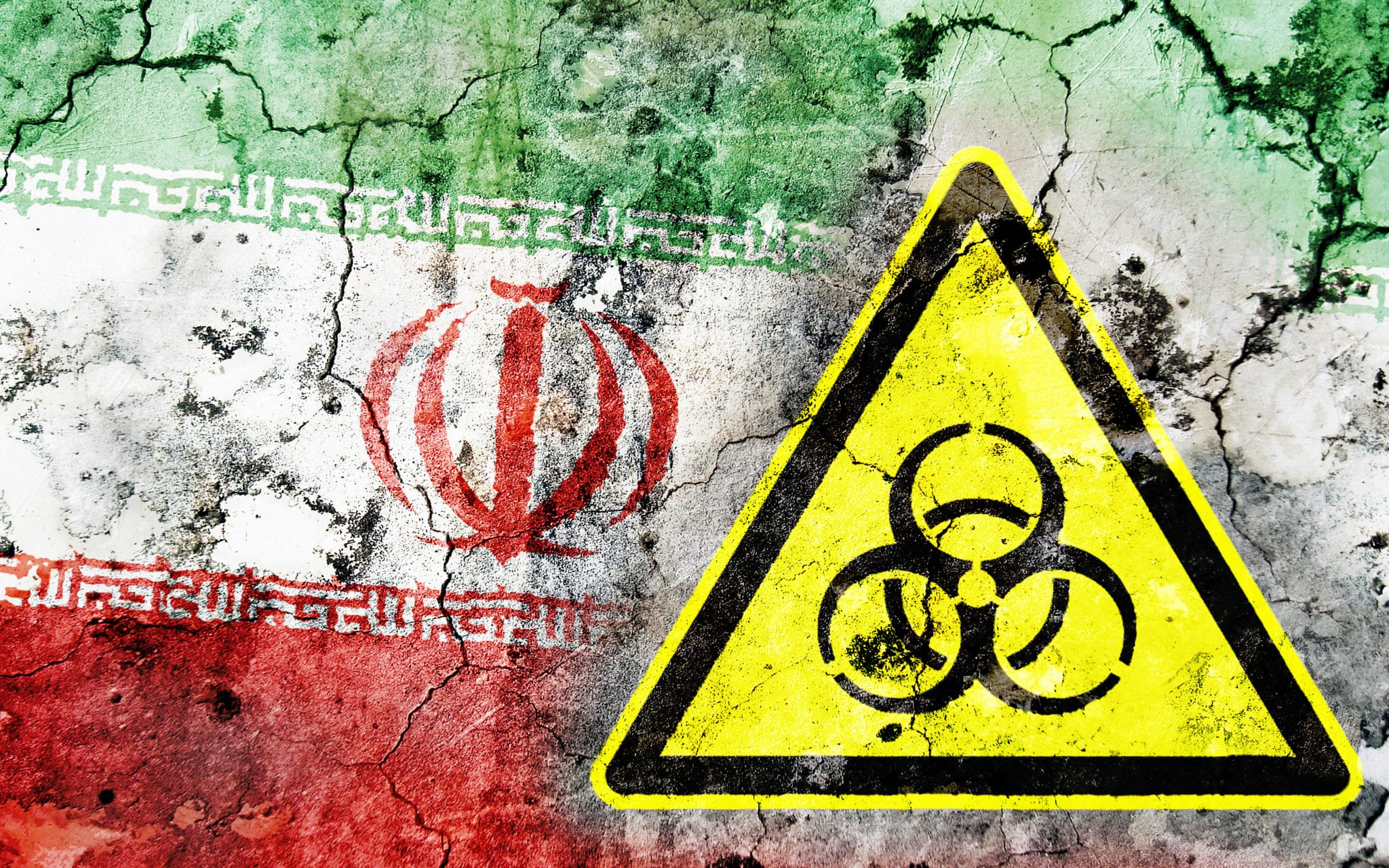
It’s no secret that Iran and the U.S. are getting closer than ever to war with each other.
Earlier this year in March, Russian and Iranian foreign ministers said they were committed to helping Venezuela’s government and opposition “find mutual understanding.”
Via Telsur:
“Russian Foreign Minister Sergey Lavrov and his Iranian counterpart, Mohammad Yavad Zarif held a Tuesday phone conversation in which they discussed “the current situation in Venezuela,” and their shared dedication to a peacefully resolution for the South American nation.”
Since then, tensions between Iran and the U.S. have gotten significantly worse. So much so that the Pentagon just revealed plans to send 10,000 troops to the Middle East.
Via AP News
“The Pentagon on Thursday will present plans to the White House to send up to 10,000 more troops to the Middle East, in a move to beef up defenses against potential Iranian threats, U.S. officials said Wednesday.”
It’s no wonder half of all Americans believe that the United States will go to war with Iran “within the next few years.”
That’s a scary thought considering that Iran just told us it just quadrupled its uranium-enrichment production capacity and is on pace for weapons-grade level production.
Via AP News:
“Iran quadrupled its uranium-enrichment production capacity amid tensions with the U.S. over Tehran’s atomic program, nuclear officials said Monday, just after President Donald Trump and Iran’s foreign minister traded threats and taunts on Twitter.
Iranian officials made a point to stress that the uranium would be enriched only to the 3.67% limit set under the 2015 nuclear deal with world powers, making it usable for a power plant but far below what’s needed for an atomic weapon.
But by increasing production, Iran soon will exceed the stockpile limitations set by the accord. Tehran has set a July 7 deadline for Europe to set new terms for the deal, or it will enrich closer to weapons-grade levels in a Middle East already on edge. The Trump administration has deployed bombers and an aircraft carrier to the region over still-unspecified threats from Iran.”
In other words, yet another country at odds with the U.S. could soon have a nuclear arsenal of its own.
Don't Miss Our Next Report !
...get a free monthly subscription to one of the best-performing investment letters: the Equedia Letter
*Don't worry. We will never spam you and our subscription comes only once per month. You can unsubscribe anytime with a simple click.
Conclusion
There are simply too many countries now aggressively pursuing and expanding their nuclear capabilities that I could sit here and go on for hours about them.
For example, Germany’s armed forces are already studying the possibility of acquiring nuclear bombers capable of using the new American B61-12 atomic bombs.
Meanwhile, growing tensions between Pakistan and India are kindling further nuclear ambitions.
Just as Indian Prime Minister Narendra Modi secured a landslide general election victory, Pakistan told the world that it had conducted a training launch of a Shaheen II, surface-to-surface ballistic missile, which it said is capable of delivering conventional and nuclear weapons at a range of up to 1,500 miles.
This should come as no surprise as India has been secretly turning itself into a nuclear power.
Via India Times:
“A leading American foreign policy journal today alleged that India is building a top-secret nuclear city to produce thermos nuclear weapons which would upgrade the country as a nuclear power and unsettle its two major neighbours – Pakistan and China.”
I hope you now understand the risks of rising global tensions.
Now, you may be wondering, what does this all have to do with investing?
The answer is two-fold.
One…
Tensions like this almost always occur when the global economy and stock markets are nearing a peak. As countries deploy more protectionism-style policies, such as the current trade war with China and the U.S., stocks tend to fall or flat line at best.
Furthermore, as I mentioned in a 2017 Letter, inflation could pick up under Trump’s protectionism-style policies:
“As Trump’s policies begin to see success, the Fed will likely raise rates and contract the money supply. They will need an excuse to do it, and what better excuse than a rise in inflation caused by Trump policies.
When this happens, another Great Depression could occur. Of course, following that, we’ll need to be “saved.”
Fast forward to today and the prices of consumer goods are already expected to climb as a result of the Trade War:
- Walmart says higher tariffs on China goods will increase prices for U.S. shoppers
- Error! Hyperlink reference not valid.
- Trump’s Trade War With China Could Cost the Average Family Up to $2,300 a Year, Report Estimates
The list goes on. If this Trade War continues, inflation will follow.
That doesn’t mean stocks have no more room for growth – especially if the Federal Reserve intervenes – but if the Trade War continues, it will eventually lead to a prolonged period of little to no global growth.
Two…
During these times of uncertainty, companies involved in the defense sector generally do very well – we have already seen how resilient these stocks have been over the last month when compared to the rest of the market.
The world is getting smaller and ever-more crowded. New global powers are now challenging the dominance the U.S. has had for many decades.
When the throne is challenged, everyone gets hurt.
What do I mean? Just watch the second last episode of Game of Thrones…
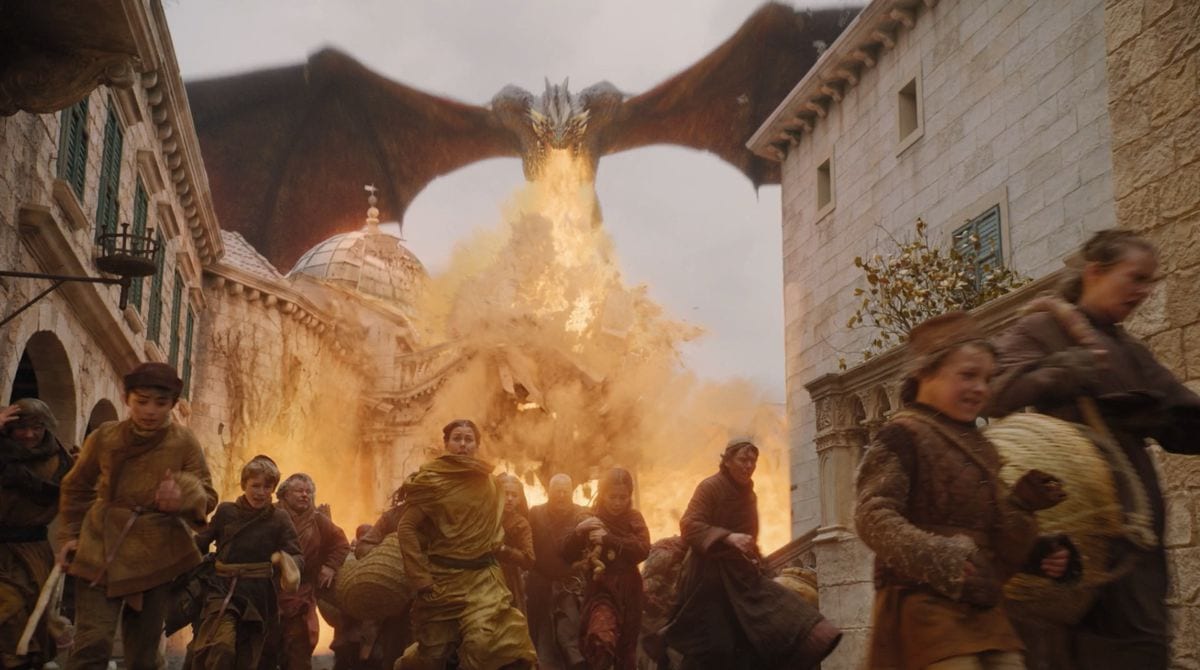 Until next time.
Until next time.
Seek the truth,
Ivan Lo
The Equedia Letter
Disclosure:
Equedia.com and Equedia Network Corporation are not registered as investment advisers, broker-dealers or other securities professionals with any financial or securities regulatory authority. Remember, past performance is not indicative of future performance. This article also contains forward-looking statements that are subject to risks and uncertainties that could cause actual results to differ materially from the forward-looking statements made in this article. Just because many of the companies in our previous Equedia Reports have done well, doesn’t mean they all will.


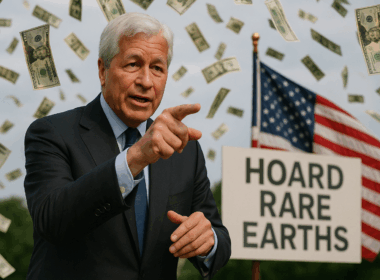
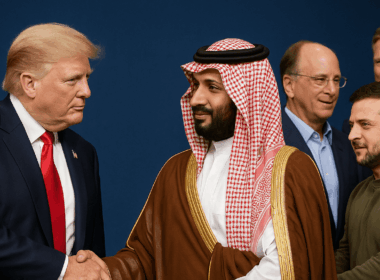


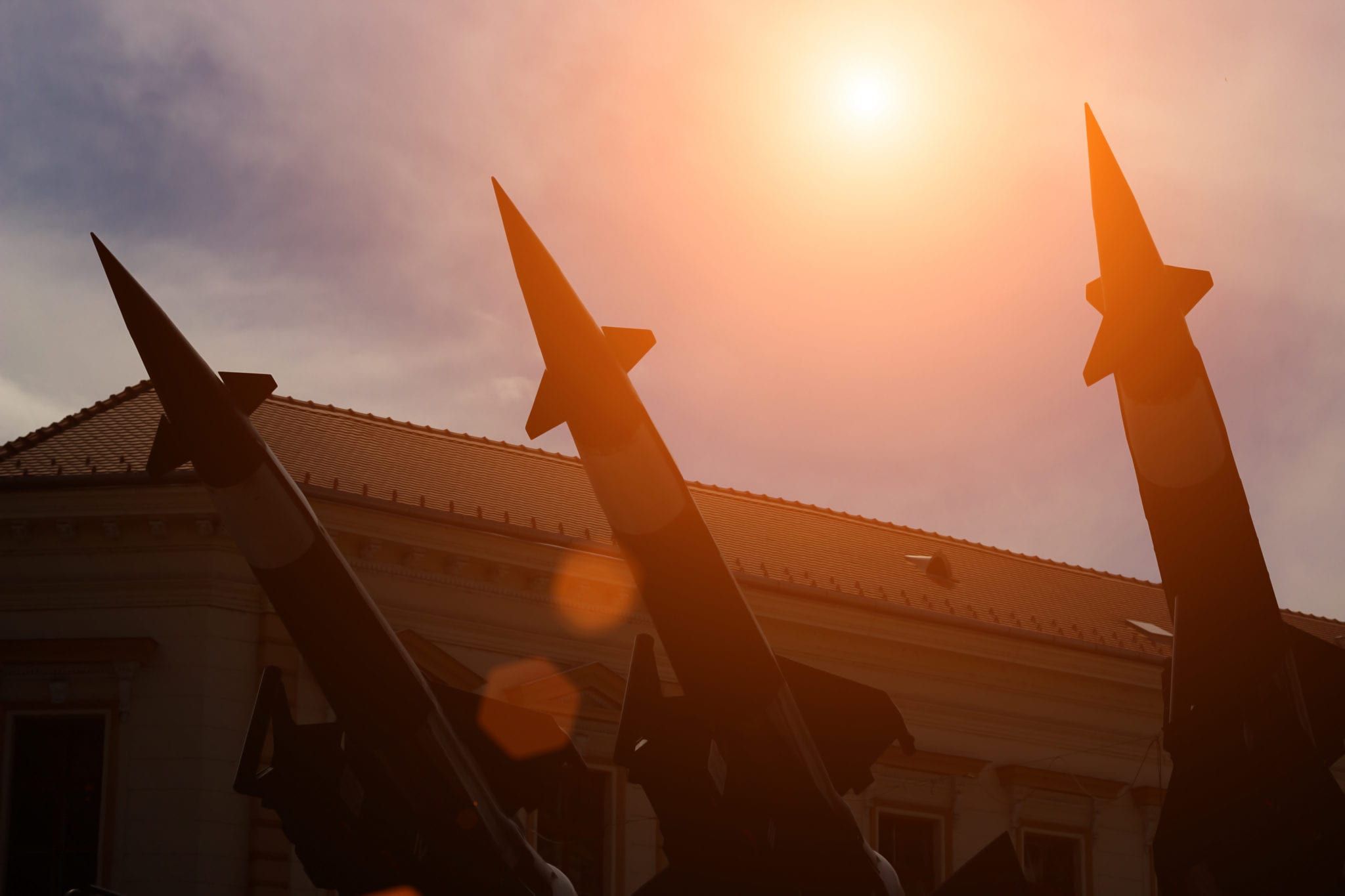


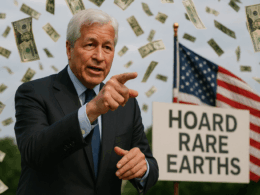
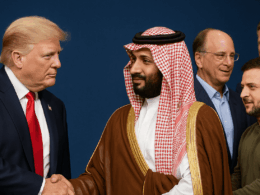


economy
Thanks for your insight. Too bad our media is so concentrated on impeaching President Trump they can’t look at anything else far more important. Keep us posted. Thanks again.
Although your fundamental thesis is very disturbing, I can’t help but agree with it. The war cycle is heating up, and there would be no winners in a nuclear war.
Our space friends tell us that NO Nuclear Weapon will be allowed to detonate ever again. The Earth is to fragile.
While you make some very valid points you fail to take all your points to a logical conclusion. The US has indeed become involved in a trade war with China and that war has come about because the trade between the nations has been way too one sided, and that one the side of China. Our corporations have invested greatly in the Chinese economy in producing goods consumed there and around the world. Yet they have applied tariffs on our goods that could and are sold there.They have also taken our patented processes and utilized them to their advantage with no consideration in return. They have managed to obtain great advances in their technology from previous administrations which put them in a greater place of threat and that without any increase in trade position. Secondly, we are in a treaty which makes us responsible for the safety of many of the nation’s in that area which keep us investing in better ways to assure that safety. Thus if we fail to insure the safety in any way we fail in our treaty agreements and place all nations in any way dependent upon us to be less safe. I am incomplete agreement that a peaceful means must be saught after to remedy the situation as it exists, yet until that is found or even an arena whereby the seeking may be safely and securely carried on we are obligated to be in a place of adequate defense. You will need to consider the consequences of our failure in terms of your peaceful existence as well.
Agree James A. Jordan. There is a reason Earthlings have not been back to the Moon space ship since the early 70’s and why the recent Israeli space craft crashed on the moon…
You used a term, “Global Reset.” And you used this term as defined result from world war.
Are you so narrow minded to not think all of Mankind can live in harmony without war?
Are you so shallow in your pondering to not see any other means for a “Global Reset?”
You follow the path of black hats.
White Hats will prevail.
Sorry, but your comment is a little strange. I never said global reset is war. If read correctly:
“Unfortunately, massive global resets have only really occurred as a result of war.
Are we on that path?”
Previous global resets were a result of war, but that doesn’t mean it has to continue that way. Things change. Hopefully white hats do prevail.
I dint watch any of the silly Game of Thrones shows..I had better things to do.
So, since I didn’t watch it,..what are you trying to say? –and why didn’t you just spell it out for us?..or is this just another “teaser” for a subscription to somrthing?
As always, Eric is spot on. Great article. Yet, way too much is missing here as to why our President Trump is understandably committed to a ‘Trade War’. Fair Trade anyone? What fair trade. There is no fair trade with China period which is not noted in the good article. Trump is doing what He has to do to protect Americans including Canada. Do you believe what Russian government has to say. Is Russia intentionally violating the agreements on arms? Of course! And Russia brags about violating the arms agreements by showing off their weapons of destruction which violate the agreements. USA is always made out to be the bad guy especially by Canadians so this is just par for the course. Too many think if it okay for other countries to take advantage of USA whether trade of arms agreements and when other countries do not play fair, USA is always made out to be the bad guy. So few people really understand what President Trump is up against at home and abroad. Venezuela… please. NO one gives a rip about the people, nobody, except our President. Oil, we have enough in USA; not a problem for US. But who care about the people in South America as China puts a stranglehold on any nation it deals with unfairly. Malaysian Prime Minister caught onto this right away and killed the China deals which China quickly said they could cut the cost by 50% and still make money, Corrupt governments are accepting help from China and then China owns those countries. Outright corruption and colonial control but it is okay because it is China and not USA. Russia is so filthy corrupt in government they even write about it. Not a good enough balanced article but yet a good article warning, yes, China and Russia are ganging up on USA and I will say it. The day will come, Russia and China will nuke the USA and then no more USA problem. See how you like that afterwards….
1- Military Supremacy
No doubt that many countries mentioned like Russia, Iran, China & North Korea want to flex their muscles & fearmonger the world about their military capabilities, so the US really have no choice but to follow suit and do likewise to protect the rest of us. The real irony is that although the US want countries to dismantle their nuclear arms capabilites, they are more than willing and would also say daring and provoking countries into combat. That’s what a war states & big brother does best & with NATO backstopping them I wouldn’t mess with them.
2- US-China Trade War:
Fixing the US IP Issue: US companies that want to setup shop in China, already know the rules of the Communist regime which include giving away their Intellectual Property & then sum to China. Since US companies still operate there, it becomes the cost of doing business. If US companies don’t like doing that, move elsewhere. Likewise should be done for China companies setting up shop in the US.
Fixing the US Deficit Issue:Tell China to square the deficit difference on their terms (which I believe they are/would do because they said they would buy more soy, wheat or whatever) otherwise the US apply a tariff on the deficit difference.
The Real Issue: The US are afraid China will soon take over technological dominance (in 5G, AI, IOT, Robotics etc.) which they cannot stand for and becoming dependant on Chinese manufacturers. So how does the US plan to slow down their progress? Fearmongering & blackballing tactics. Tell China their infringing on their national security. This is the real battleground not trade deficits or IP theft.
Criminal insanity – Doing the same thing over and over again and then expecting different results…
It is generally accepted that the “bubble” this time is massively worse than 2007 with no ‘tools’ left to re-inflate it and instead of dealing with that reality, the “elite” are trying to rearrange the deck chairs as they secure the best life boats while the presstitutes are ‘orchestrating’ the plebs and getting them arguing on which chairs they are going to sit on instead of throwing the parasites overboard… WTF could possibly go wrong?!?!?
And see “The Big Short”?
After all that film revealed about the criminal insanity and CDO ponzi scams, the last caption read….
“In 2015, several large banks started selling billions in something called a “bespoke tranche opportunity.”
Which, according to Bloomberg News, is just another name for a CDO.”
Well this sums it all up again…”You have no idea of the crap people are pulling (STILL) and everyone is walking around like they’re in a goddamn Enya video”!
https://www.youtube.com/watch?v=jmCN4F9SgNY
Read the book of Revelations. There is coming a period of 3 1/2 years of tribulation in which Christians shall be murdered for their faith in large numbers. Currently there are on average, 11 Christians murdered each day in the world. Mostly in 45 different countries. But the antichrist movement is growing each day with the western nations persecuting Christians in many ways. But its only started and will get far worse. After the 3 1/2 years of tribulation, Christ shall rapture the dead in Christ first, and the remaining believers who are still alive. Then all hell shall break loose as the presence of God shall be completely removed from the earth and satan shall have his reign on earth for 3 1/2 years. Those who are true believers, and those who repent and come to Christ for salvation have no worries. Its the ones who remain rebellious to God and attack His people who have everything to worry about.
Ivan, you sign off with “Seek the Truth”. Well then you need to read feedback written by Terry Schmitt, Reddog, Dinitri and Stan Hoffman. Read each 10 times to get your brain educated!!!! You don’t understand “FAIR TRADE” or “Socialism” which is really “COMMUNISM”. Never in history could a Communist government be trusted…..Russia, China, Venezuela, Cuba, Iran, N.Korea, Vietnam and on and on. These country leaders MURDER any opposition. Putin will be Russia’s leader for life. Just like China.
How about writing an article on how many people China executes every year…..clue….it is in the millions!!!
Obama handed out 10 Trillion taxpayer dollars, mostly to bail out the big banks and non of these big bank bastards go to jail.
I dare you to Write about that……….Mr. “Seek the Truth”!!
Not sure what you mean by this Bob. Or why you are so upset. No one said to trust Russia, or China in this matter. This is simply a matter of what is happening around the world.
We have also written many articles re: the Big Banks. Many. And, in those articles, we explain how the biggest bank of all, the Federal Reserve, controls everything.
My hope is that readers read the entire article. In fact, please read the Letter before this – where we compare Trump to JFK and how Trump is directly attacking the establishment. Not to mention, we said Donal Trump would become President, long before he became President.
Please do not be so quick to jump to conclusions.
Here is our last Letter. Hopefully it sheds some light: https://www.equedia.com/a-most-radical-prediction/
The US is commanded by an insane group of warmongers. The arms race would not exist if it were not for its constant aggressive imperialistic desire for world hegemony since 1945. Neither Russia nor China has made any significant aggressive interference in other countries around the world. The US exists to foment perpetual war, be it with arms, invasion, covert operations or sanctions. If a nuclear war occurs, it will be on the head of America.
Hello Ivan Lo,
Your analysis and insight are well above an average person. Albert Einstein was stated to have said, something like, you really are not a good subject matter teacher until you can explain it to a child. Yet, I enjoy and appreciate pondering all your commentary, Thank You.
My question is, can you define household debt v expenses v disposable income? (with %ages)
Best Regards,
JB
Despite this world’s troubles, there is good news that the near future will be a global paradise under a new Global Government, GOD’S Kingdom, directed from Heaven. I do recommend:
https://www.jw.org/en
http://tv.jw.org/#en/home
How come all you economists have forgotten the High Inflation-High Unemployment period called Stag-flation that lasted from the end of the Nixon Presidency to the Reagan era? And what the Fed did to cure it? Are low wages and low prices due to Mexican and Chinese cheap production, the cure for Stag-flation?
Please let me know what you think. If Trump succeeds in his boast to bring back American factories, would that bring back high prices and lead to Stag-flation? I had a mortgage, so I hated the cure, which was High Interest Rates.
It is the first time I read this info. I wish the high school would put this early learning into Money world so that we can learn early to use our head with money matter and not just graduate and find a job in the hope of security without knowing the world around us
I f I have learnt these back before 2008 , I may have get a away with shocking brankcruptcy not knowing what the hell is going on.
Keep writing in simple term and wish many average guys can get access to it. You may well help thousand of average people avoid heavy debts and depression
Thank You for excellent info
economy